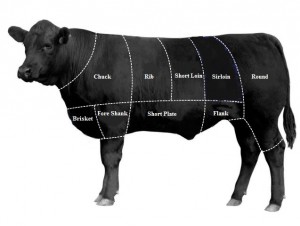
Beef is the meat of domesticated cattle, specifically steers, raised principally for consumption. A beef carcass is first divided into primal cuts. Each primal cut is then reduced into sub-primal cuts. Individual portions derived from sub-primal cuts are referred to as fabricated cuts.
The primal and sub-primal cuts have distinctive characteristics based on the amount of muscle tissue, which give meat its characteristic appearance. The amount of connective tissue determines the tenderness of the meat. Muscle tissue, composed of cells held together by connective tissue, is 72% water, 20% protein, 7% fat, and 1% minerals. The cells of muscles which are in more frequent use contain more connective tissue. Therefore, cuts of meat from the chuck or shoulder, which are in constant use, are tougher than those from the loin, or back, which have less muscle.
Connective tissue contains collagen (a membrane) or elastin (tendons and ligaments) which connect the muscle to bone. Collagen breaks down into gelatin and water when cooked using moist heat. Elastin, on the other hand, remains stringy and tough so, it is best to remove these tendons and ligaments before cooking.
There are eight USDA quality grades for beef.
The primal cuts of beef are:
Other areas on the steer that produce cuts:



